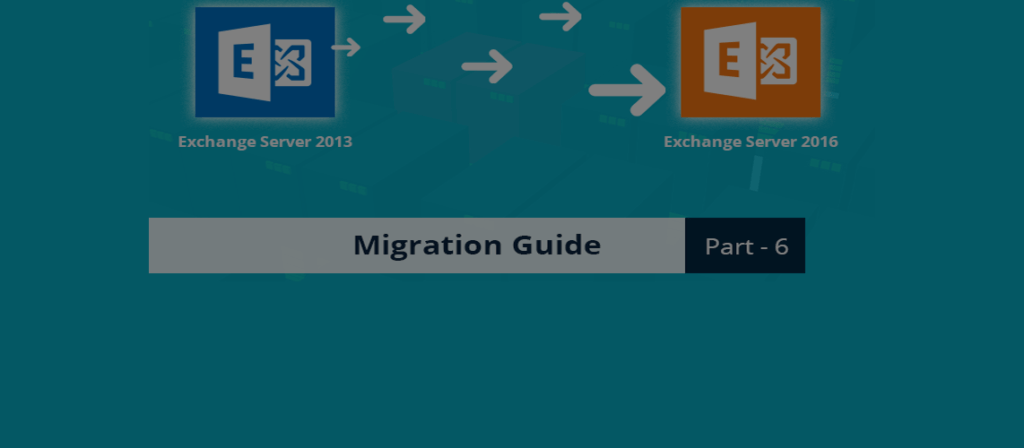This is the final part of our series of blogs on the process of migrating from Exchange Server 2013 to 2016. In the previous post, we showed you how to move user mailboxes and public folders to the new Exchange Server.
To read other parts in this series, go to:
Exchange 2013 to Exchange 2016 Migration (Part 1)
Exchange 2013 to Exchange 2016 Migration (Part 2)
Exchange 2013 to Exchange 2016 Migration (Part 3)
Exchange 2013 to Exchange 2016 Migration (Part 4)
Exchange 2013 to Exchange 2016 Migration (Part 5)
Exchange 2013 to Exchange 2016 Migration (Part 7)
Instant Solution - Exchange Migrator
Exchange/Office 365 migrations are quite easy with professional tools like Exchange Migrator. This tool helps to manage mailbox and public folder migrations involving different Exchange versions and deployment types. Also, this tool helps with all tasks starting from the pre-migration analysis to the preparation of reports after the migration.
In this part of the blog, we are going to migrate email relaying receive connectors and other devices/applications to Exchange 2016 and uninstall the old Exchange Server.
Migrating email relaying receive connectors and other applications to Exchange 2016
Any devices and applications relaying emails through Exchange Server 2013 have to be migrated to the new Exchange Server 2016. To do this, you have to create the same receive connectors on Exchange 2016 that you have on Exchange 2013 and configure them with the same authentication settings, IP ranges, and permission groups.
After you have created the new receive connectors, modify the settings of your applications/devices so that they relay emails through Exchange Server 2016. If you’ve configured your applications/devices to use a DNS name, such as smtp.www.edit13.com, then you can simply change the A record/CNAME record to resolve to Exchange Server 2016 server IP.
The next step will involve decommissioning Exchange Server 2013 – so if you have any applications that use Exchange 2013, they should be migrated to 2016 before this step.
Uninstalling Exchange Server 2013
Before uninstalling Exchange 2013, ensure that all services running on the software have been stopped. It is advised that you shut down all services one by one so that the server can be decommissioned. If all services have been stopped and there are no problems, you can be confident that the old server is no longer required for any Exchange services as they have all been migrated to Exchange 2016.
To uninstall Exchange Server 2013, follow the below steps:
- Go to add/remove programs and double click on “Microsoft Exchange Server 2013”. A confirmation window will open up; select “Yes” from the options.
- Remove Exchange Server wizard will start. Click Next to proceed.
- Exchange setup will then run a few checks to make sure that Exchange Server can be uninstalled from the system without any complications. After the test is complete, click uninstall to proceed.
- The Exchange Server uninstallation will start. Don’t disturb the setup while the installation is in progress.
After the uninstallation is complete, proceed to reboot the system, take it out from the domain, and take out the AD computer objects to complete decommissioning of the server.
Conclusion
In the final part of our blog series, we have shown you how to migrate email relaying receive connectors and application/devices to Exchange Server 2016. We have also taken you through the steps for decommissioning Exchange Server 2013. The process of migrating from Exchange 2013 to 2016 is time-consuming and involves numerous steps that you have to be careful not to miss. Trying to do this using native processes can be counterproductive for any IT team that has strict deadlines to meet. Fortunately, there are automated solutions, like ;Exchange Migration, that simplify and speed up Exchange migrations, allowing IT teams to focus on more important tasks.
In our next series (Part 7), you can see how smoothly the automation software can help you migrate mailboxes from Exchange 2013 to Exchange 2016.
FAQs
Q. How much time does it take to uninstall Exchange Server 2013?
A. After you have removed all the connections from Exchange Server 2013, it will be easier to uninstall it and not take much time.
Q. How can I disable all the services of Exchange Server 2013?
A. you need to go to the Run application and type services.msc to open all the services. Disable each Exchange Service one by one.
Q. Can Exchange Migrator uninstall the Exchange Server 2013?
A. The software does not uninstall any application or service. But, it can roll back any committed migration, and for that, you should not uninstall Exchange 2013.
Q. Can I migrate all my mailboxes at the same time?
A. Yes, you can choose all the mailboxes and migrate them simultaneously.
